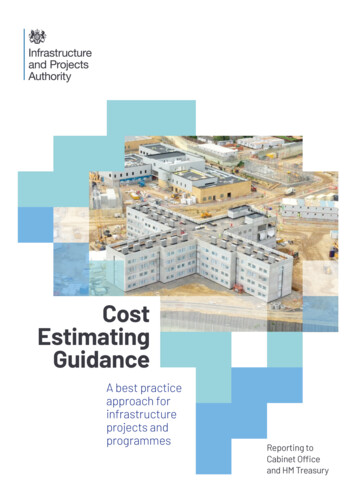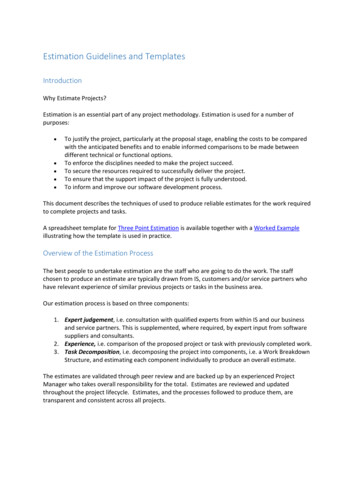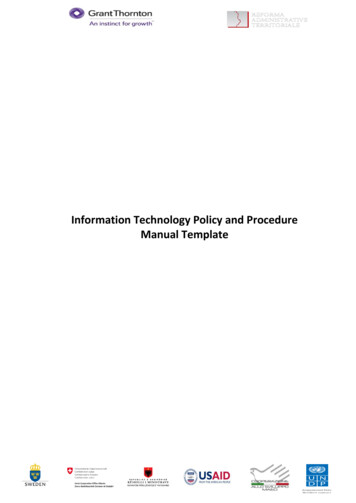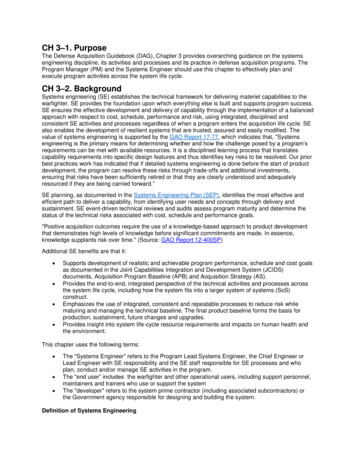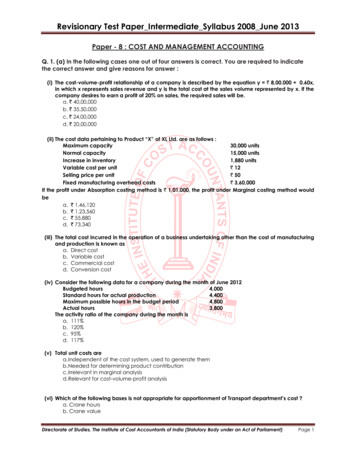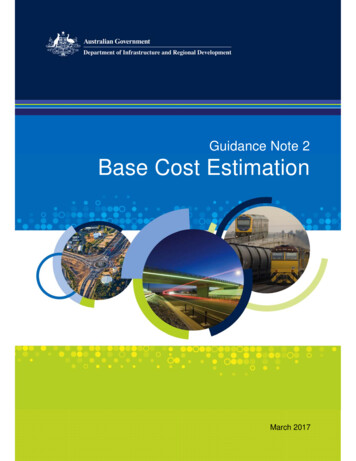
Transcription
Guidance Note 2Base Cost EstimationMarch 2017
Commonwealth of Australia 2017ISBN 978-1-925531-29-9March 2017 / INFRASTRUCTURE 3180Ownership of intellectual property rights in this publicationUnless otherwise noted, copyright (and any other intellectual property rights, if any) in this publication is owned by the Commonwealth ofAustralia (referred to below as the Commonwealth).DisclaimerThe material contained in this publication is made available on the understanding that the Commonwealth is not providing professionaladvice, and that users exercise their own skill and care with respect to its use, and seek independent advice if necessary.The Commonwealth makes no representations or warranties as to the contents or accuracy of the information contained in thispublication. To the extent permitted by law, the Commonwealth disclaims liability to any person or organisation in respect of anythingdone, or omitted to be done, in reliance upon information contained in this publication.Creative Commons licenceWith the exception of (a) the Coat of Arms; and (b) the Department of Infrastructure and Regional Development’s photos and graphics,copyright in this publication is licensed under a Creative Commons Attribution 3.0 Australia Licence.Creative Commons Attribution 3.0 Australia Licence is a standard form licence agreement that allows you to copy, communicate andadapt this publication provided that you attribute the work to the Commonwealth and abide by the other licence terms.A summary of the licence terms is available from .en.The full licence terms are available from lcode.This publication should be attributed in the following way: Commonwealth of Australia 2017.Use of the Coat of ArmsThe Department of the Prime Minister and Cabinet sets the terms under which the Coat of Arms is used. Please refer to theDepartment’s Commonwealth Coat of Arms and Government Branding web page s/guidelines-and-procedures-other-agencies and in particular, the Commonwealth Coat of Arms - Information and Guidelinespublication.Contact usThis publication is available in hard copy or PDF format. All other rights are reserved, including in relation to any Departmental logos ortrade marks which may exist. For enquiries regarding the licence and any use of this publication, please contact:Director - Publishing and CommunicationsCommunications BranchDepartment of Infrastructure and Regional DevelopmentGPO Box 594Canberra ACT 2601AustraliaEmail: publishing@infrastructure.gov.auWebsite: www.infrastructure.gov.au2Cost Estimation Guidance – Guidance Note 2 “Base Cost Estimation”Version 1.0 March 2017
Document informationDocument NameBase Cost EstimationVersion and Date1.0: March 2017Prepared byBen du BoisApprovalsApproval andAuthorisationNamePositionDatePrepared byBen du BoisCivil EngineerMarch 2017Change and ProjectReviewMajor InfrastructureProjects Office (MIPO)Reviewed byWarren FletcherDirectorMarch 2017Change and ProjectReviewMIPOApproved byAndrew DanksGeneral ManagerMarch 2017MIPORevision historyIssueDateRevision Description1.0March 2017Initial releaseBefore using any downloaded PDF version, or printed copy of the PDF version of this GuidanceNote, readers should check the Department’s website at the below URL to ensure that the versionthey are reading is current. Note that the current version of the Department’s Cost EstimationGuidance supersedes and replaces all previous cost estimation guidance published by theDepartment, other than that already included in current versions of the NOA and NPA (refer tosection t Estimation Guidance – Guidance Note 2 “Base Cost Estimation”Version 1.0 March 2017 3
Table of Contents1:Introduction .61.1:Context and Authority .61.2:Related Guidance .61.3:Availability and Version Control .71.4:Objective and Scope of Guidance Note 2 .71.5:Cost estimating challenges .81.6:Definitions and Abbreviations .92:The Base Estimate .132.1:Estimating methods .142.2:Estimate Preparation .152.2.1: Estimate Validation .162.3:Construction Costs .172.3.1: General .172.3.2: Approaches to calculating Construction Costs for road projects .202.3.3: Approaches to calculating Construction Costs for rail projects .202.4:Client’s Costs .213:Work Breakdown Structure .223.1:Appropriate Level of Detail .244Cost Estimation Guidance – Guidance Note 2 “Base Cost Estimation”Version 1.0 March 2017
4:Project Cost Breakdown Template .264.1:Differences between Road and Rail PCB templates .274.2:WBS and PCB Element Content .274.2.1: Client Costs .284.2.2: Contractor’s Direct Costs .294.2.3: Contractor’s Indirect Costs .294.2.4: Client Supplied Materials and Services .295:Conclusion .33Appendix GN2-1: Estimate Checklist and Design Maturity Matrix .34Appendix GN2-2: Indirect Costs Checklist .35Appendix GN2-3: Road and Rail PCB Templates .37Cost Estimation Guidance – Guidance Note 2 “Base Cost Estimation”Version 1.0 March 2017 5
1: Introduction1.1: Context and AuthorityThis Guidance Note – Base Cost Estimation is one component of the suite of documents that inaggregate, constitute the Department of Infrastructure and Regional Development (theDepartment) Cost Estimation Guidance.The base cost estimate will typically represent the greatest proportion of the cost of a project and isthe starting point for the determination of contingency and escalation allowances. Therefore it iscrucial it be as accurate as possible because contingency and escalation estimates, together withthe Base Cost Estimate, comprise the Project Outturn Costs at the various contingency levels.The Cost Estimation Guidance (the Guidance) is referred to in Appendix B to the “Notes onAdministration for Land Transport Infrastructure Projects 2014-15 to 2018-19” (the NOA). TheGuidance outlines the principles that must be followed by proponents in preparing cost estimatesaccompanying Project Proposal Reports, submitted in accordance with the NOA, which seekAustralian Government funding for road and rail infrastructure projects. The NOA and theassociated National Partnership Agreement on Land Transport Infrastructure Projects (NPA) areavailable at the following link: ojects/The Cost Estimation Guidance comprises the following key components: Overview; Guidance Note 1 (Project Scope);Guidance Note 2 (Base Cost Estimation); Guidance Note 3A (Probabilistic Contingency Estimation);Guidance Note 3B (Deterministic Contingency Estimation); andGuidance Note 4 Outturn (Escalation) Cost Estimation.In particular, this Guidance Note establishes the principles and framework for developing andpreparing a project base cost estimate. Applying the principles and framework herein is intended toresult in consistent, realistic, auditable, and appropriate project base cost estimates at each phaseof the project life cycle. This Guidance Note should be read in the context of the Overviewcomponent of the Guidance and the specific requirements of the NOA.1.2: Related GuidanceAdditional useful guidance on cost estimation practices, to the extent that they do not contradict theguidance provided by the Department’s Cost Estimation Guidance, may be found in individualagency cost estimation guidance or manuals, and in the guidance provided by professionalassociations e.g. Project Management Institute, Australian Institute of Quantity Surveyors, RoyalInstitution of Quantity Surveyors, or AACE International.6Cost Estimation Guidance – Guidance Note 2 “Base Cost Estimation”Version 1.0 March 2017
1.3: Availability and Version ControlThe Cost Estimation guidance is subject to periodic update, and hence is not available from theDepartment as a printed bound document. Rather it is being published on the Department’swebsite in PDF form, both as individual components, as well as a single consolidated document,that can either be read online or downloaded for subsequent use. A number of Excel spreadsheetsand presentations accompany the various components of the guidance to illustrate variousaspects.The PDF components of the Guidance, and the accompanying spreadsheets and presentationsare available from the Department’s website /projects/index/cost-estimation-guidance.aspx, andare the current versions of the guidance. The version date of each component of the “CostEstimation Guidance” will be listed on the above webpage and will also appear as Appendix A“Current Component Version Status – Cost Estimation Guidance” to the “Cost EstimationGuidance Overview” document.1.4: Objective and Scope of Guidance Note 2The objective of this Guidance Note is to foster an improvement in the way in which baseestimates for infrastructure projects are prepared and presented. This guidance aims not to beprescriptive, but rather describes the methodology of how to develop a robust base cost estimateas well as providing broad descriptions of the typical elements of a base cost estimate for road andrail infrastructure projects.The guidance covers the following topics: Definition of a Base Estimate - description of the key components of a base cost estimate; Base Estimate Preparation - guidance on the methodology and tools used to develop abase estimate; Work Breakdown Structures and use of the Department’s Project Cost BreakdownTemplate - guidance on developing a Work Breakdown Structure and its relationship to theDepartment’s Project Cost Breakdown and associated template; and Elements of a Base Cost Estimate - an overview and broad description of the componentsof a base estimate.This Guidance Note is premised mainly towards base cost estimation practices expected to beutilised in major or high risk projects. However, the principles apply generally to projects of allsizes. It applies only to Capital Cost Estimating and does not consider Operation and Maintenance(O&M) costs. While determination of O&M costs may be required for other financial and economicanalyses, such as Cost Benefit Analysis, it does not form any part of the subject matter of thisGuidance Note.It is expected that the primary users of this document will be jurisdiction (i.e. Australian State andTerritory) public sector organisations (Agencies), including Local Government Authorities and theircontractors/consultants that have responsibility for delivering infrastructure projects. However, theCost Estimation Guidance – Guidance Note 2 “Base Cost Estimation”Version 1.0 March 2017 7
guidance may also be relevant to academics, other contractors/consultants, other organisationsand members of the public with an interest in major infrastructure projects.1.5: Cost estimating challengesDeveloping a robust base estimate requires a well-defined scope, access to detaileddocumentation and historical data, and well-trained and experienced cost analysts. Even in idealcircumstances cost estimating is difficult and requires the application of both science andjudgment. The cost estimator typically faces many challenges which may lead to suboptimalestimates – that is, estimates that contain poorly defined and unrealistic assumptions, have limitedor no supporting documentation, are characterised by inadequate data collection and inappropriateestimating methodologies, are built from irrelevant or out of date data, provide limited or no basisor rationale for the estimate, or can show limited or no defined process for generating the estimate.Some of the challenges a cost estimator may face on road and rail projects are: not having access to historical cost databases; unreasonable program baselines; unknown ground conditions or other site conditions; anduncertainty around (rail) possessions. a vague or incomplete scope;Some of these challenges are widespread, for example it appears that cost estimators in Australiado not have ready access to the kinds of historical data from Australian road projects available totheir US or European counterparts from their projects.8Cost Estimation Guidance – Guidance Note 2 “Base Cost Estimation”Version 1.0 March 2017
1.6: Definitions and AbbreviationsTable 1: Definitions and Abbreviations1TermDefinitionAgencyA state or territory government body that generally will deliver aninfrastructure project.AssumptionA documented, cost-related factor that, for the purpose of developing abase cost estimate is considered to be true, real or certain.Base DateA ‘base date’ is a reference date from which changes in conditions,(including rates and standards) can be assessed. In the context of a baseestimate it is the date for which the rates included in the cost estimatereflect current market conditions.Base EstimateThe sum of the Construction Costs and Client’s Costs at the applicablebase date. It represents the best prediction of the quantities and currentrates which are likely to be associated with the delivery of a given scopeof work. It should not include any allowance for risk (contingency) orescalation.ConstructionCostsThe costs required to complete the activities or tasks associated with theconstruction elements of a project.Client CostsIn this guidance note, ‘client’ is taken to mean the project proponent.Client costs are the costs incurred by the proponent (for example, publicsector delivery agency) to develop and deliver a project.Contractor DirectCostsAll Contractors’ costs directly attributable to a project element including,but not limited to, plant, equipment, materials, and labour.Contractor IndirectCostsCosts incurred by the contractor to perform work but which are notdirectly attributable to a project element. These generally include costssuch as preliminaries, supervision, and general and administrative costs.ContingencyAs per Appendix B of the Notes on Administration: “.the component of aProject’s cost in excess of the Project Base Estimate that accounts for, orreflects, risk”.Contingency aspects do not form part of the scope of this document. Forfurther information refer to Guidance Notes 3A and 3B.1Definitions have been derived, where appropriate, from AACE International Practice No. 10S-90: Cost Engineering TerminologyCost Estimation Guidance – Guidance Note 2 “Base Cost Estimation”Version 1.0 March 2017 9
TermDefinitionEscalationThe component of a project’s total cost at any point in time that reflectschanges in prices and costs since the Base Cost Estimate date.Escalation is added to the Project Cost to obtain the Outturn Cost.Escalation aspects do not form part of the scope of this document. Forfurther information refer to Guidance Note 4, “Escalation”.Escalation RateThe Department derives escalation rates from actual or forecastcomposite index series that reflect the characteristics of infrastructureprojects, where the escalation rate in any financial year is calculated fromthe average of the composite quarterly indexes for that financial yeardivided by the average of the composite quarterly indexes for theprevious financial year.EstimatorThe person or organisation that prepares a cost estimate.First PrinciplesEstimateThe method of preparing a cost estimate by calculating the dollar ratesand rates of productivity required to complete each of the individual taskswithin the Work Breakdown Structure.JurisdictionAn Australian state or territory.LabourEffort expended by people for wages or salary.MarginAn allowance that includes the construction contractor’s corporateoverheads and profit.MaterialAn article, material, or supply brought to a construction site by theContractor or a subcontractor for incorporation into the work. Alsoincludes any items brought to the site preassembled from articles,materials or supplies.NOAThe Notes on Administration for Land Transport Infrastructure Projects2014-15 to 2018-19 provide administrative guidance for managingprojects to be funded under the National Partnership Agreement.NPANational Partnership Agreement on Land Transport InfrastructureProjects.Outturn CostThe sum of the price-escalated costs for each year of a Project’sduration. Outturn Cost calculation requires the non-escalated ProjectCost to be presented as a cash flow and the application of an escalationfactor for each project year to derive the price escalated cost for eachyear. The Department’s Project Cost Breakdown Template can be usedto calculate outturn costs. In economic terms non escalated costs areoften referred to as Real costs while Outturn Costs are often referred toas Nominal costs.10Cost Estimation Guidance – Guidance Note 2 “Base Cost Estimation”Version 1.0 March 2017
TermDefinitionOverhead(s)A cost or expense inherent in the performing of an operation, (e.g.,engineering, construction, operating, or manufacturing) which cannot becharged or identified with a part of the work, product or asset and,therefore, must be allocated on some arbitrary basis believed to beequitable, or handled as a business expense independent of the volumeof production.PCBProject Cost Breakdown.Project CostThe Base Estimate Cost plus an allowance for contingency and generallyprefixed by the applicable “P” or probability level. The Project Costreflects costs as at the Base Estimate Date.PlantAll plant, motor vehicles, appliances and things (for example, scaffoldingand formwork) of whatsoever nature used or in use in or about theexecution of the Work, but does not include materials, plant, equipmentintended to form or forming part of the Works.Project ProposalReport (PPR)A statement detailing the scope and benefits of the project submitted byproponents as part of the project approval process.Project scopeThe work that must be performed to deliver a product, service or resultwith the specified features and functions.SubcontractorA contractor that enters into a subcontract and assumes some of theobligations of the primary contractor.Sunk costsCosts which have already been incurred, such as investigation, research,and design costs. Sunk costs are included in an outturn cost.Work BreakdownStructure (WBS)A hierarchical decomposition of the work to be executed to accomplishthe project objectives and create the required deliverables. The WBSorganises and defines the total scope of the project.Cost Estimation Guidance – Guidance Note 2 “Base Cost Estimation”Version 1.0 March 2017 11
Table 2: The Phases of a Project for Australian Government Funding PurposesPhaseDescriptionIdentificationThe Project Identification phase requires an appraisal/study of broadalternatives such as road and rail technology, travel demandmanagement, land use etc. to solve a particular transport problem. Theappraisal considers how well the broad alternatives to address theproblem meet the Infrastructure Investment objectives and identifies apreferred alternative solution for progression to the Project Scopingphase.ScopingProject Scoping entails the investigation of specific options (such as routeselections for a bypass) that achieve the preferred alternative to addressthe transport problem studied in the Identification phase. For each of thespecific options a business case analysis is required which shouldaddress the Benefit Cost Ratio (BCR), the finances, the scope andbudgets/timing (including contingency at P50 and P90 and escalation) foreach option, recognising that costs estimates are likely to be based onlimited information and hence contingencies are likely to be high. Apreferred option will be the result of the business case analysis and theoutcome of the Scoping Phase.DevelopmentProject Development entails detailed planning (such as environmentalapprovals, land acquisition, community consultation) and design (such asfield studies, preliminary detailed design, quantity estimates) of thepreferred option and the development of a updated BCR, detailed andrefined project budgets/timings (including a pre-tender estimate) and aprocurement method. This phase might also involve some preconstruction or preliminary construction work.DeliveryProject Delivery entails construction and commissioning of the preferredoption following a procurement process and the selection of aconstruction contractor. Preliminary works (relocation of services,earthworks etc.) could precede the main construction contract. Progressreporting and progress claims are required from the proponent at regularintervals during this phase.Post CompletionThe Post Completion Phase comprises all activities after a Project isComplete until the Project is Closed. This phase is not expected toexceed 12 months.12Cost Estimation Guidance – Guidance Note 2 “Base Cost Estimation”Version 1.0 March 2017
2: The Base EstimateAt the highest level, the Base Estimate (including sunk costs) is the sum of two key components;the Client Costs and Construction Costs as at the applicable base date and which should cover allphases of the project. The base estimate should be prepared based on the estimator’s bestassessment of the quantities and market rates that will be required for a given scope of work at thetime the estimate is prepared. Allowances for Contingency (inherent and contingent risks) orEscalation do not form part of the base estimate and should not be considered at this point of theestimating process.Figure 1 below indicates schematically where the Base Estimate fits into the overall structure of anOutturn Cost Estimate:Figure 1: Components in the structure of an Outturn Cost EstimateCost Estimation Guidance – Guidance Note 2 “Base Cost Estimation”Version 1.0 March 2017 13
2.1: Estimating methodsThe aim of any estimating process is to generate the most accurate reflection of the known projectscope at the time the estimate is prepared. For that reason, the most appropriate cost estimatingmethodology may change as a project moves through its life cycle and the scope is refined orchanged. For example, there is unlikely to be sufficient information available at the ProjectIdentification phase to justify committing the resources required to prepare a detailed first principlesestimate, and where a higher level of confidence in the estimate may be achieved through theapplication of an order of magnitude estimate.The common methods used in the preparation of estimates are briefly outlined below. Note that forthe purposes of meeting the Department’s requirements of estimate reliability, a first principlesestimate is expected to have been undertaken at the Development and Delivery phases forprojects with an anticipated total outturn cost of over 25 million seeking Commonwealth funding.Global estimatingGlobal (or order of magnitude) estimating is a method of estimating involving the use of ‘all in’ or‘global’ composite rates such as road cost per kilometre. As such the estimate may be consideredto consist of one element only.Composite estimatingComposite estimating is a more refined method than using global rates as it involves the use ofrates that include the combination of a number of work items to construct a single element of theproject. The estimate is generally considered as having a small number of estimating elementsonly such as: drainage, environmental works, or traffic management costs per km, or bridge costsper square metre of deck area.Unit rates estimating (based on historic rates)Unit rate estimating calculates the cost of each item of the project by multiplying the quantity ofwork by historical unit rates. The project cost is then determined by the sum of the elemental costs.Unit rates are typically obtained from previous tenders for similar rate and are commonly sellingrates that include indirect costs, contractor contingencies, margins and allowances.First principles estimatingThe first principles method involves the calculation of project-specific costs based on a detailedstudy of the resources required (Plant, Labour, Material and Subcontract) to accomplish eachactivity of work contained within the project’s work breakdown structure (WBS). Productivityassumptions are applied to all labour and plant costs with adjustments made to account for uniqueor unusual site characteristics.Hybrid (unit rates/first principles) estimatingThe hybrid method uses some features of the unit rate method and some of first principlesestimating which can result in an increased accuracy of estimate over that of the unit rate methodwithout requiring the resource investment required of a full first principles estimate.14Cost Estimation Guidance – Guidance Note 2 “Base Cost Estimation”Version 1.0 March 2017
2.2: Estimate PreparationInsufficient attention to the quality of inputs and the approach to the preparation of estimates willlead to unreliable results. Important aspects to consider when preparing estimates are: using appropriately qualified and experienced staff e.g. trained Quantity Surveyors orspecialist estimators;using an appropriate Work Breakdown Structure (WBS); the project scope definition and requirements; using appropriate software tools to assist in developing and presenting the Base Estimate;and using applicable benchmarking and cost databases where available to validate costestimates.using the input and review by experienced people to increase the estimate’s reliability;Generally, the main issue underlying the reliability of any cost estimate is the ability toappropriately define the project scope. The scope description defines what is, and what is notincluded and is the starting point for any base estimate. Readers are referred to Guidance Note 1(Project Scope) for a more detailed explanation and for guidance on project scope definition.Significant inaccuracies in base cost estimates are generally a consequence of poor scopedefinition. Attempting to develop a base estimate without a reasonable and consistent level ofdefined scope is merely ‘guesswork’ and is of little value to those seeking to establish and managea project budget.The uncontrolled or unapproved additions and alterations to a project after the scope has beendefined (scope creep) are likely to result in additional costs. This will undermine the originalestimate as any cost estimate can only represent the defined scope of work. For example,McKinsey & Company2 found that with bridge replacements, changes made by owners to thescope of projects tend to be the biggest cause of cost and schedule overruns.An estimate should identify costs for all scope items to the maximum extent possible for the phasethe project is in. Where information is insufficient or unavailable and assumptions must be made inorder to prepare the base estimate, these assumptions should be noted and recordedappropriately. Any inclusions listed as assumptions should be adjusted or removed when moredetail becomes available.As a project progresses from the Scoping to Development phase, the robustness and detail ofunderlying information which supports the estimates should increase. Cost estimates can benefitfrom refinement during the course of a project to reflect the additional detail available. It isexpected that the accuracy of a project estimate will increase as the project progresses through itsdifferent phases. An example of an Estimate Ch
1.5: Cost estimating challenges Developing a robust base estimate requires a well-defined scope, access to detailed documentation and historical data, and well-trained and experienced cost analysts. Even in ideal circumstances cost estimating is difficult a



